
Sage & Onion Levain
This is one of my favourite breads at this time of year. It smells just like stuffing and makes the best leftover turkey sandwiches! It's also great with turkey soup. This is a naturally leavened bread made with fresh, ripe sourdough starter so you can only imagine the smell permeating my kitchen when this bakes - sourdough bread with sage and onions! I usually bake the bread in the Italian bread pans in long loaves, but wanted to see how it turned out baked in the cast iron pots. In a word, it turned out good!

I used 100% hydration bread flour starter, fed and left to ripen overnight. The basic ingredient list is pretty simple:
- 85% bread flour (I use Rogers Silver Star bread flour)
- 15% whole wheat flour
- 70% water (warmed to around 90 degrees)
- 2% sea salt
- 25% starter
Note that the overall hydration is higher than 70% as I just calculate the percentage of starter as a single ingredient, without breaking it down into flour and water percentages. As the starter is 100% hydration this affects the overall dough hydration. It works, at any rate.
The added ingredients are onion and sage. For the onion, I rehydrate dehydrated minced onion in an equal amount of boiling water and let it sit until cool. Use as much as you want (probably around a quarter cup of rehydrated onion per 750 gram loaf). The sage is sometimes chopped fresh sage from my garden, and sometimes rubbed dried sage from the bulk store, depending on the season.
Mix the flours, water and starter well and let sit for 30 minutes or so. Add salt, onion and sage and incorporate well, using whatever method suits you best. I sometimes do this in my stand mixer, and sometimes use Ken Forkish's method (folding and pincering; see https://www.youtube.com/watch?v=HoY7CPw0E1s).
I stretch and fold the dough three or four times over the next couple of hours, and the rest varies depending on what kind of time I have available or what my schedule is. This last batch was fermented at room temperature for about four hours, then in the fridge for another three or four hours. I then shaped it and put it in baskets lined with floured napkins (seam side down as per Ken Forkish). We then went out to see Star Wars and I left the proofing loaves, tucked into plastic bags, in the cool basement. My starter tends to be very vigorous so I didn't want them to overproof.

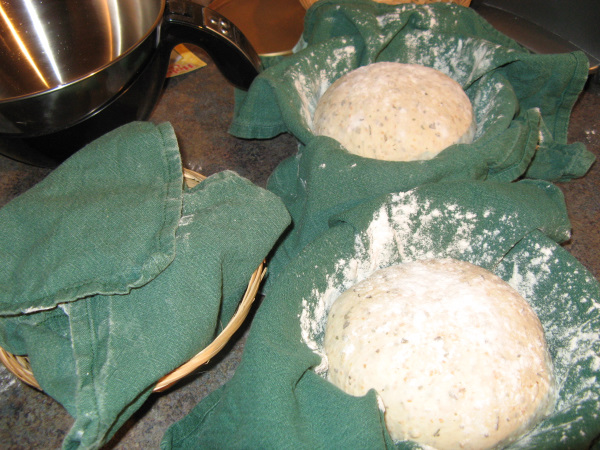
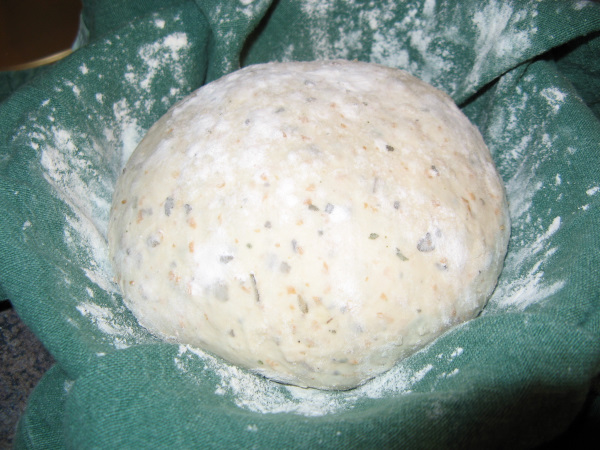
Once home, I pre-heated the cast iron pots in the oven at 475 degrees, for about 45 minutes. The loaves went into the pots seam side up so I didn't have to score them (they bloom naturally at the seams). 20 minutes with lids on, then another 20 minutes with lids off. The bottom crust was very dark, the top was awesome and the interior temperature was around 205 degrees. They sang as they cooled and I went to bed (late) with the scent of fresh bread filling my head!

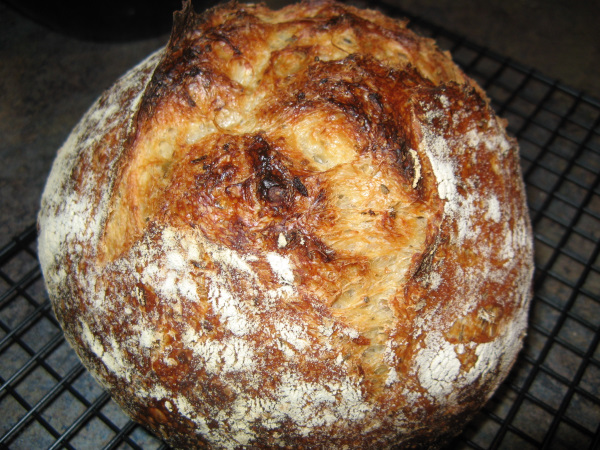
This morning I cut a couple of slices to take to work with me, along with a pot of home made turkey soup. Very impressed with the crumb - it was moist, creamy and shiny. I had thought the dough was under-proofed when I put it in the oven, but any more proofing and it would have been a bit too holey for me. All in all, a success!
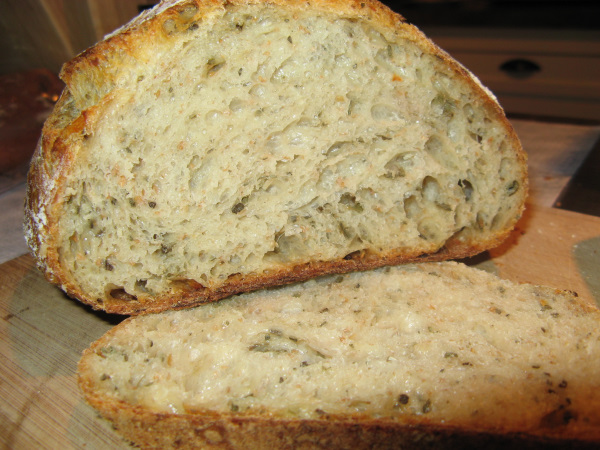


Comments
inside and out. Has to smell up the house when balking and that is a good thing. Well done and happy baking!
Totally, looks amazing! Looks crunchy! (?)... want some.
lovely glistening interior. You must either have quite a large mixer or forearms like Popeye from the hand mixing! That's a lot of bread for a home baker in one load.
alan
Hi Alan. No, I have quite a small KA mixer that can only do a good job with dough for two loaves at a time. When I bake a batch of 8 I either do 4 batches of 2 each (a pain, especially when I autolyse for 30 minutes. It takes forever!), or I do dough for 4 or more loaves at a time using Ken Forkish's method. I have a bit of arthritis so stirring with a spoon is painful for me, but mucking in with both hands (gloves on) and folding / pincering works for me. I've got pretty good guns for an old lady! :)
Really lovely. Would you mind if I featured this on the home page for a bit?
Mind?! My goodness, I'd be thrilled and honored! This is such a wonderful bunch of artisans. Thanks, Floyd!
Lazy Loafer, this is more then fantastic looking bread! I am so intrigued by the combination of adding (how didn't I remember it first!!! :) ) I am however, fairly intrigued by how would it taste with caramelised onions as I am not a fan of raw onions! Beautiful bread!
My mouth is watering Lazy Loafer! Very nice bake! I'm definitely going to try Sage and caramelized onion.
And beautiful job on the oval loaves as well. They look fantastic. Seems like you have a really great recipe down that works for you.
Cheers!
Dave
I love the idea of caramelized onions in bread (they are so, so yummy). However, they pose a bit of a dilemma. I use re-hydrated minced onion in this bread so I can mix the onion into the dough at the first stages, while it's still relatively easy to incorporated ingredients like these. They are firm enough that they don't disappear into the dough (which would give a lovely flavour but not the presence of onion bits). If I do that with nice, soft, oily caramelized onions they just seem to vapourize into the dough. Again, lovely flavour but you lose something.
On the other hand, trying to incorporate said soft, oily caramelized onions into a finished, developed dough is almost impossible. I do sometimes roll sauteed onions (cooked soft in EVOO with a little rosemary, salt and pepper) into my whole wheat beer loaves, but that gives you the usual spiral gap in the bread once it's baked and I don't really like that either.
I'm open to suggestions!
I don't seem to have the issue you have mixing in the caramelized onions in my doughs. I do however use a mixer first for 5-6 minutes on low speed and then add the onions and mix for 1 minute which incorporates them nicely. I then do 2-4 stretch and folds 15-20 minutes apart. I have a Bosch Universal which allows me to mix larger amounts of dough then a standard Kitchen Aid. You can still try this using your KA and see if it works for you.
Either way, great bake!
I'm planning to try this bread over the next weekend. Have an onion idea/suggestion and a question for you ...
First off, the question. Considering two medium-sized loaves, about how much fresh (or dried) sage would you suggest? I realize you're kind of eyeballing things on the additions, but I'm just wondering if you have any measurement-based suggestions? I'm okay with experimentation (cooking this for myself, at first) but sage can be quite overpowering so I thought I'd ask.
On the onion question, I have an idea. Am thinking of trying this out over the weekend and will report back if this works, but here goes ... do a generous-sized dice on a white or sweet onion, soak the dice in scalding hot water briefly to eliminate some of the overpowering tendencies a white onion can have (I'd prolly skip this step with a sweet onion). Drain and dry the diced onion VERY well, then pop into the fridge for a hard freeze. Once well-frozen, the diced onion should incorporate much more readily into the fully-risen dough, even moreso if the dough leans toward the slack/wet consistency. I've not test-driven this dough so I've no idea what consistency to expect. The potential danger of course is that the frozen onion will seep too much liquid into the loaves while baking and/or steam them too much from the inside out, but I'm thinking with thorough drying (as in, overnight?), this might be doable. The same idea might work with caramelized onion: brown them up, dry the heck out of them, freeze and then incorporate.
Going to give this more thought & will experiment a bit over the weekend, but I'm wondering what your thoughts might be ... ?
As I said in another comment:
Sometimes I use fresh onion too. When I do I usually chop it then spread it on paper towels to dry for a bit before incorporating it into the bread. Freezing it might work but I suspect that it would release a lot of moisture as it thawed, into the dough, and leave pockets.
I keep looking at this lovely crumb and seriously want to take a bite!:)
I know, right? It is awesomely good. I love it when it turns out right (not that it always does!)
When you're rehydrating your onions, do you use an equal amount of water by weight or volume?
And how much sage do you typically use?
I use equal amounts by volume of hot (boiling) water and dehydrated minced onion, then measure the rehydrated onion into the dough once it has cooled. As for the sage, I usually use about a quarter cup of rubbed sage (pressed down into the cup) for two loaves, but that varies depending on my mood, and I use less if it's chopped fresh sage from the garden (which is much stronger in flavour).
I love sage and onion stuffing, I can only imagine how beautiful it is in sourdough loaf.
May I ask if you used dried onions or did you saute them and cooled them before adding them to the dough?
I can almost taste the bread. Yummy
As I said in the post, I use dehydrated minced onion, rehydrated in an equal amount (by volume) of boiling water. See previous comments for a discussion of the pros and cons of dehydrated versus sauteed (caramelized) onions.
I found a great flour from Wessex Mill in Uk, they have Onion Bread Flour.
It is Wheat Flour which has added dried onions.
I got it at the Farmers Shop but can also order it online :)
They have fantastic flour.
Petra
Those look absolutely fabulous :-)
Would be lovely to make sandwiches with cold roast pork as well. I'm so going to have to try this...
Wow! its looks delicious, my mouth is watering. You have inspired me to experiment with a similar ingredients! Thanks for the post.
Sounds incredible!
I'm trying this out as part of my weekly bake. Have just mixed in the onions, sage and my levain into my 3kg dough and will be baking tomorrow morning. Will report back how they were. So far mixing in sauteed onions worked just fine. We'll see.
The bread turned out great. There are some extra holes where the onions are, they probably brought too much water into the dough there.
I did find the smell of the dough after it had fermented in the fridge for a night and while it was baking kind of overwhelming so was a bit scared the bread would be too strong, but it turned out just fine. I made three in my weekly batch of 8 breads.
thanks for the formula, this is a keeper!
Wow! Nice loaf! I am working my way through FWSY and this is one of the first breads I am going to make once I am done the book which will be very soon.
Great looking loaf! I made one of my own. It was fantastic.
Looks very beautiful and delicious!
Those look lovely! My question actually has nothing at all to do with the loaf formula, but rather about your proofing baskets--I'm curious how you've managed to use napkins without any sticking? I thought I was going to have to resign myself to buying some couche linens online, because every time I've tried a floured dishtowel/basket approach to proofing, I've had such a nightmare with dough sticking! What's your secret?
Hmm, not sure what the secret is! They are regular cotton napkins. I flour them well, and will use brown rice flour for really wet doughs. I make sure I make a nice tight boule; the 'skin' seems to help. I've never had a problem with this bread but have had with Ken Forkish's really hydrated doughs.
I have made versions of this recipe twice since finding it featured here. Very good. Love the oven spring and not having to slash is nice. I have not made with the sage and onions yet. The first time I added re-hydrated onions as per the recipe plus crumbled bacon and some aged cheddar. Today's loaves I made it with Herbs de Provence, kalamata and green olives, and toasted walnuts (I would attach a picture but can't figure out how to do so). Smells great but hasn't cooled enough to slice yet.
My method is to mix the dough and ferment the first day. Fermentation takes about 5 hours with my starter. I then divide, shape, and put in lined baskets. These are allowed to proof at room temperature for an hour and then put in the refrigerator overnight (about 18 hours). Then I bake in the morning on the second day. Works great!
Thanks for the recipe!
Aha! I think I figured out the picture thing.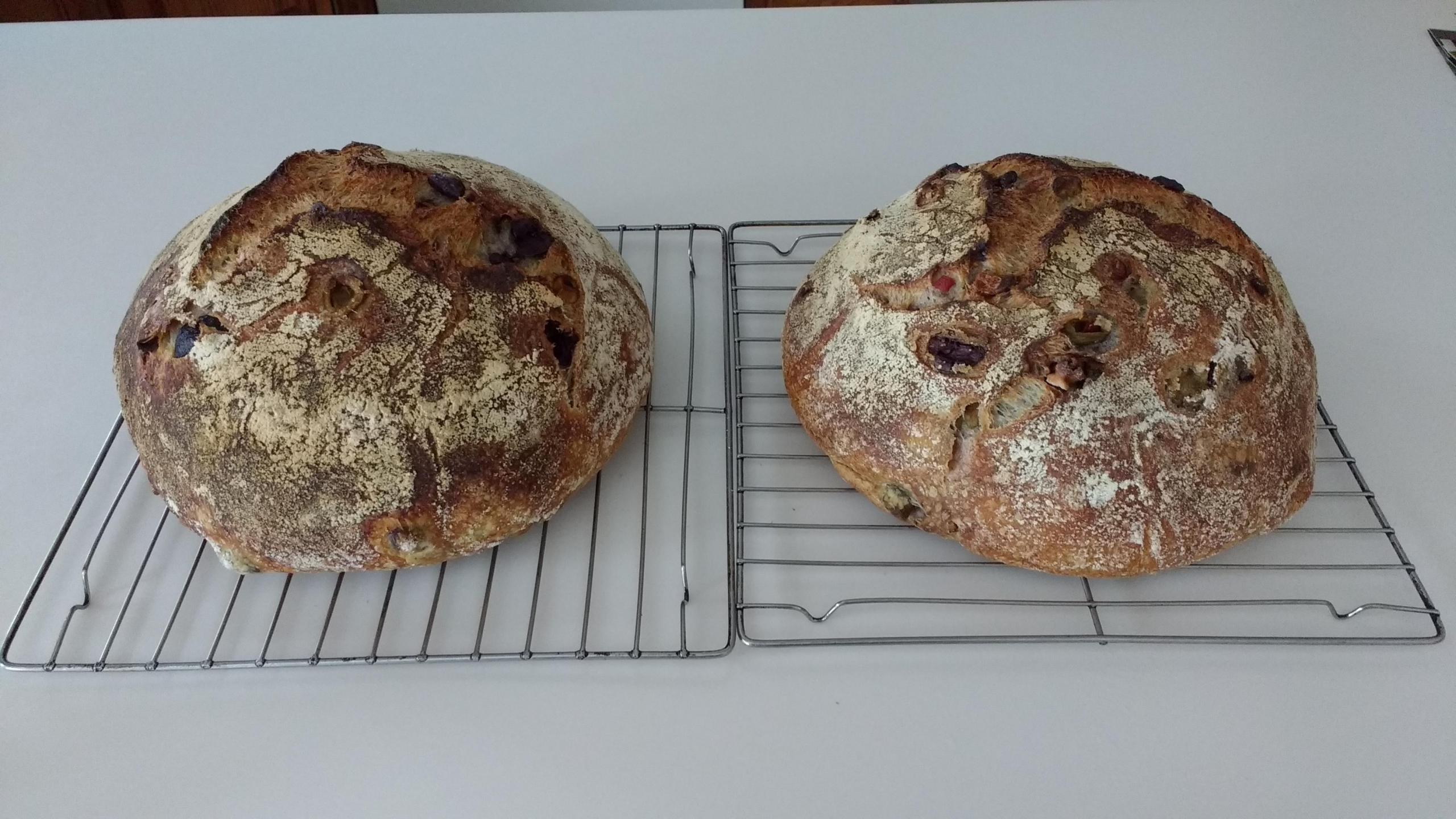
Yes, I use this general-purposed levain for several of my breads, including my Three Friends (Tom[ato], Olive & Rosemary) bread. Sometimes I bake it in the round iron pots and sometimes in long loaves, depending on how many I want to make (so, what will fit in my oven at once time). If I make it for the iron pots I might proof it in the fridge in baskets overnight, but usually shape and proof the long loaves in the morning. Otherwise they could get quite out of hand rising in the Italian bread pans!
I love your add-ins. Hope you figure out how to post pictures! Let us know how today's bread tastes.
Hello Lazy Loafer - I just joined The fresh loaf, yet admittedly been a voyeur here for some time. I recently took my first baby steps toward real bread baking after reading Artisan Bread in 5 minutes a Day and using their method. Now that I understand more about how bread works, oven spring, proofing and such... I ask if you used dutch ovens in that beautiful loaf instead of steam. I would love to make a boule of such righteous magnitude, that is a great presentation!
Welcome T. Fargo! Yes, I did use dutch ovens (well, smaller cast iron pots, actually) for the boules. However, I wouldn't expect the same kind of oven spring from the 5 minutes a day breads. I have made some of them, and baked some in the iron pots, but now I usually work their doughs a little bit rather than just mixing them up and leaving them. It develops the gluten better and they do rise better after a little kneading. Still not a good as my levain breads though.
When I bake the Sage & Onion bread in a long loaf I use steam in a pan on the bottom shelf of the oven and also spray the loaves and the oven a bit. I don't get quite as much spring as in the covered iron pots but it is still a beautiful bread.
Let me start by saying your bread looks fantastic! The loaves look just delicious.
I'm new to baking bread and new to this site. As a matter of fact this is my first post! I'm trying to make sense of your recipe so I can try my hand at it. Your recipe above shows...
I'm not quite sure I'm doing it right, but if I try to convert this to a recipe with measured amounts for 2 loaves, I come up with something like this...
Does my recipe look like a close approximation for a dough that would result in two loaves based on your recipe? If not, can you explain how I would use your recipe of percentages to formulate a measured recipe?
As I mentioned I'm new to bread baking but have become hooked in a very short time. I just purchased a larger stone for my oven, a good pastry board and various proofing baskets. I can't wait to explore the wonderful world of bread even further. This site appears to be a real treasure. Thank you in advance for any replies and advice. Cheers and good baking to you all!
Hi, and welcome! Both to the site, and to the addictive craft of bread baking. :) Let's see if I can answer your questions. First, I'm not sure from your post whether you are familiar with Baker's percentage or not. In this calculation method, the total weight of flour ends up to be 100%, so in my recipe 85% of the total flour is unbleached bread flour, and 15% is whole wheat flour, adding up to 100%. Everything else is then a percentage of this total weight of flour.
I'm afraid I don't do ounces very well, so let's talk in grams. Let's say the flour was 850 grams of bread flour and 150 grams of whole wheat flour, totalling 1000 grams. You would then use 700 grams of water (70% of 1000), 20 grams of salt and 250 grams of starter. My starter is 100% hydration, so it is half water and half flour. Using those amounts you'd end up with 1970 grams of dough. So it depends how big you want your loaves to be. I usually scale my loaves at 750 grams of dough, so my Pain au Levain weights for 2 loaves would be:
I hope this answers your questions. And you're right, this site is a real treasure! Have fun exploring... :)
Yes, this is perfect! I was not familiar with Baker's percentages, but after my post and did some more exploring/research and found information on it, however your explanation is still very helpful since you've broken it down so straightforwardly (is that a word??) for me AND given me the amounts you use for your own bread! Thank you!
Now, as far as this whole "seam side down" for proofing and "seam side up" in the pots goes, I think I get that, but to be clear....when you form the final boule shape, you proof them so the smooth side of the boule is up in the proofing basket and then when you transfer them to the cast iron pot, you just invert them from the basket to the pot which leaves the "seam side" now up in the pot removing any need to score them, correct? Thank you for indulging me, but again I'm new to this but I am very detail oriented and just want to be clear. Thank you again!
Yes, you've got it! Most of the loaves I've done with that technique (comes from Ken Forkish's book "Flour Water Salt Yeast") worked out beautifully. However, some of the ones I've done lately with very wet dough that is a bit over-proofed haven't burst at all. In those cases I don't think I'd have been able to score the loaves anyway!
For a very good tutorial on baker's percentage, check out the description on King Arthur's Flour here.
Hello Lazy Loafer,
I think I am going to try your bread this weekend. How much Sage and Onion do you add to the loaf? Trying to get a relative idea. Thanks again.
The amount is in the post and the comments above:
For my 750 gram loaves I use around 65 grams of rehydrated onion, which is probably around 1/4 cup or so for two loaves. But whatever suits your taste!
Thank you I really appreciate it!
I don't have the cast iron pots or Dutch ovens. Can I proof these in baskets and then just bake on my stone? Any advice in making them this way? Thanks.
You can certainly bake them on a stone. You just need to make sure you have some type of steaming set-up in your oven. You can use Sylvia's towel method or many others. I put a heavy duty rimmed baking pan on the lowest shelf of my oven and pour 1 cup of boiling water in the oven. I have an electric oven and the steam eventually vents itself so I don't even bother to remove the tray. This works great for me. I also have 1 stone on the second level of the oven and another on the highest level and I get great crusts every time. The pot method eliminates the need to use additional steam as the moisture from the dough when the pot is covered will self-steam. I personally prefer the other method which also allows me to make much bigger loafs when desired.
Would these 5qt pots work well with 750 gram loaves? I like the price.
Sorry here is the link:https://www.amazon.com/gp/aw/d/B00X6ZBE42?vs=1&vs=1
When I bake in iron pots I use smaller ones (2.5 litres) so I can fit more in my oven at the same time. And when I bake these in long loaves I put them in perforated Italian bread pans and bake them on the stones in my oven. Both methods work great.
Those are exactly what you are looking for and the price is definitely right. As a bonus, you don't have to replace the handle with a metal one. I use a 5 quart as well for my loaves.
Thank you. Once I have these, I think I've got just about everything I need :).
Wow-that is some beautiful, artful bread! I think my mouth is salivating from imaging the taste.
I am new to bread baking and don't understand what to apply the percentages to. can I just get cups and teaspoons? Also how do I measure hydration and what is proper for this recipe. Sorry for the newby questions.
Hmmmm, I don't actually do cups (ever) as that's a very inaccurate way to measure flour. If you scroll through the posts you'll see that someone has converted the recipe to ounces and teaspoons, and then I have given the amounts in grams. Most bakers here measure all their ingredients in grams.
As for baker's percentages - all this really means is that the flour amount is 100% (so if, say, you have 400 grams of white bread flour and 100 grams of whole wheat flour, that would be 80% of the total flour is white and 20% is whole wheat. All the rest of the ingredients are shown as a percentage of the total flour weight. So if you had 350 grams of water in that dough, then it would be 350/500 which is 70% water, or 70% hydration. I won't complicate matters at this point by figuring the hydration of the starter and how it affects the overall dough hydration, but that's the gist of it. If you read this post on King Arthur Flour (http://www.kingarthurflour.com/professional/bakers-percentage.html) it explains it in a bit more detail.
Pages